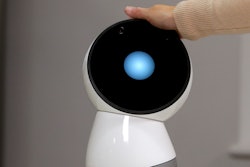Industrial Robot Tattoos Humans
Three weeks ago a team out of Autodesk's Pier 9 workshop in San Francisco released a video of the an extremely brave soul receiving the world's first tattoo from an industrial robot.
The pair of designers met at ENSCI, a french design school in Paris, where they retrofitted a Makerbot 3D printer, replaced the extruder with a tattooo needle, and began tagging their legs with classic geometric shapes and patterns.
The pair caught on with Pier 9, and according to David Thomasson, Principal Research Engineer at Autodesk's Applied Research Lab, their application is an example of the intimate relationship humans will soon have with machines.
It's a pretty intricate process in which they first 3D scan the body part, and import that into software where they add the graphics and build the pattern, before they export it to the robot.
Now, the makers stress, don't try this at home, but had they not hacked a 3D printer at home, they'd never be at Pier 9. What they really mean is try this at home, but don't tell anyone that you got the idea from us, until it's useful, and then will bring you in and help you make a big, better version of it. And hopefully commercialize it. And we’ll split the patent, and the business, because even though it was your idea, would it really ever come to fruition if it wasn’t for us?
Robots Set World Record
A new Guinness World Record was set in China two weeks ago when the Ever Win company set up 1,007 robots to dance simultaneously.
The shockingly odd number of QRC-2 robots were controlled from a single cell phone, and had to dance for 60 seconds in order for the record to count.
So how did we arrive at the arbitrary number of 1,007? Well some of the bots fell over and were disqualified. According to the company’s CTO, the feat was possible because each robot was outfitted with an encryption tech that reduced radio frequency interference.
The new record shatters the previous mark of 540, and it also proves that no matter how many times your mother tells you you’re special, sometimes it simply isn’t true.
Living in Space
As humans push to explore deep space, we still need to figure out a few details, really rudimentary, like how we’ll live, and what we’ll live in.
Well two days ago, NASA selected six U.S. companies to develop full-sized prototypes and concepts for deep space habitats that will help support human missions into deep space, and it is just a murderers' row of brain power.
- Bigelow Aerospace will develop a prototype of XBASE, it’s 330 cubic meter expandable habitat and test platform. It might look familiar, because it’s based on the expandable activity module, or BEAM, that is currently in use on the space station.
- Boeing is developing a modular habitat system that leverages the company’s experience in designing, developing, assembling on-orbit, and safely operating the International Space Station for more than 15 years.
- Lockheed Martin will refurbish a multi-purpose logistics module, like those used to carry equipment aboard the space shuttle, into a full-scale habitat prototype.
- Orbital ATK will create their prototype habitat that is based on the Cygnus spacecraft currently servicing the space station.
- Space Systems will study a flexible architecture that leverages multiple commercial launches to construct a modular long-duration habitat. Their prototype will be based on the Dream Chaser cargo module.
- NanoRacks will try to convert an existing launch vehicle’s upper stage, or propellant segment, into a pressurized habitable space.
The work will be the next step in how NASA will use public-private partnerships to expedite human missions to Mars, and beyond.
---
This is Engineering By Design.






















